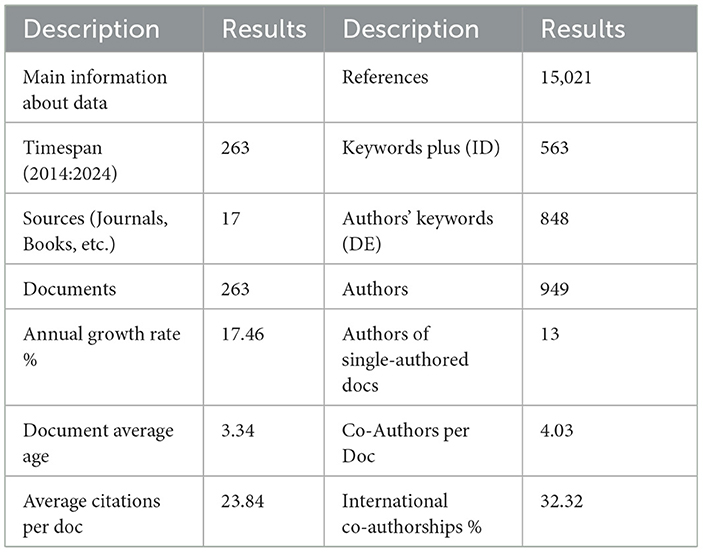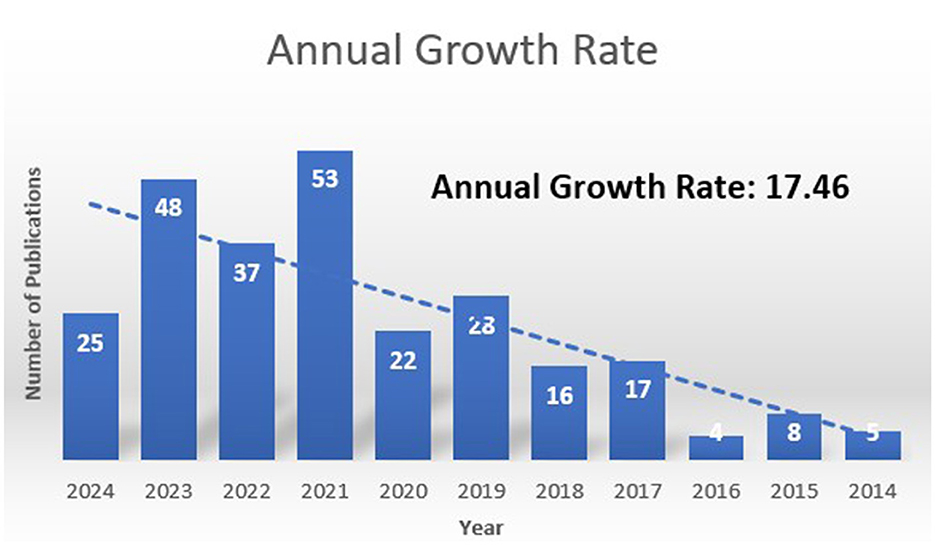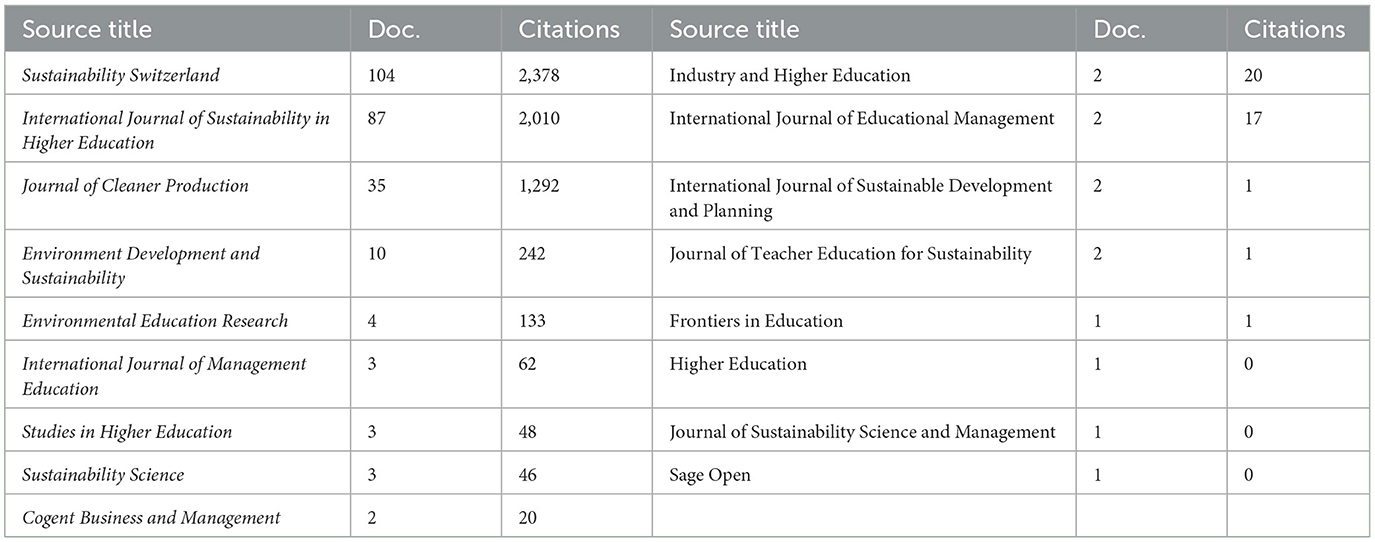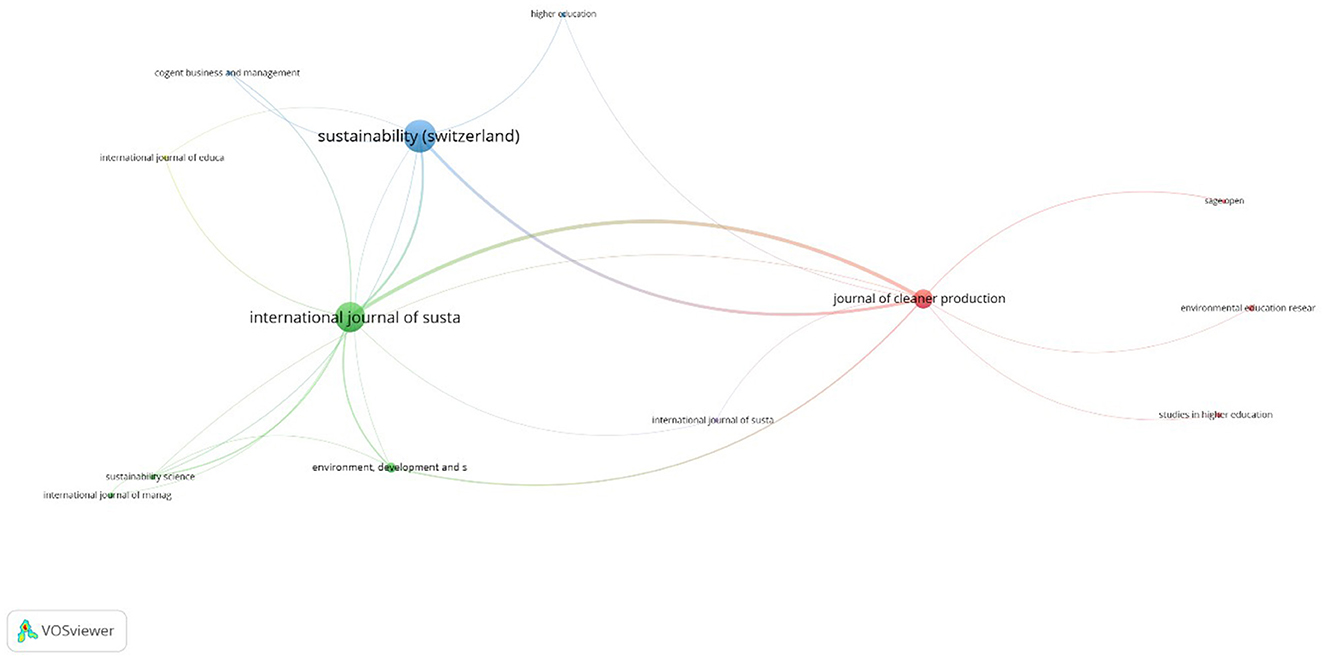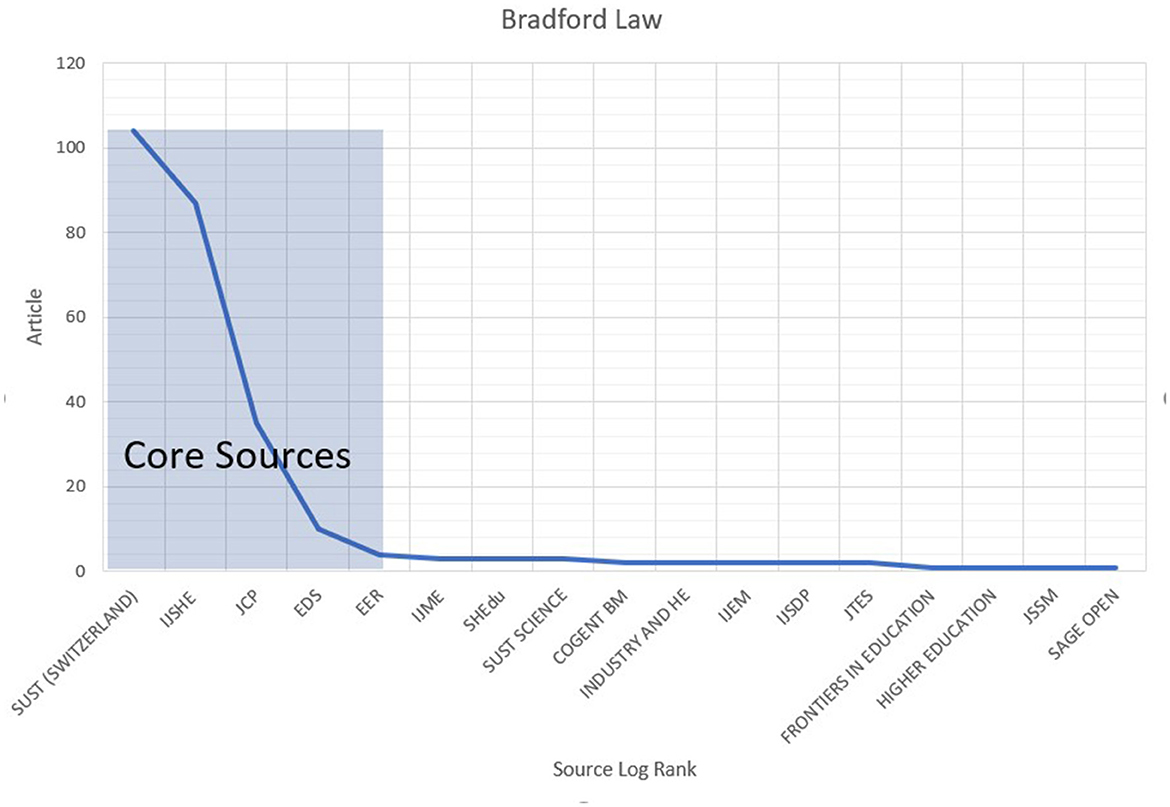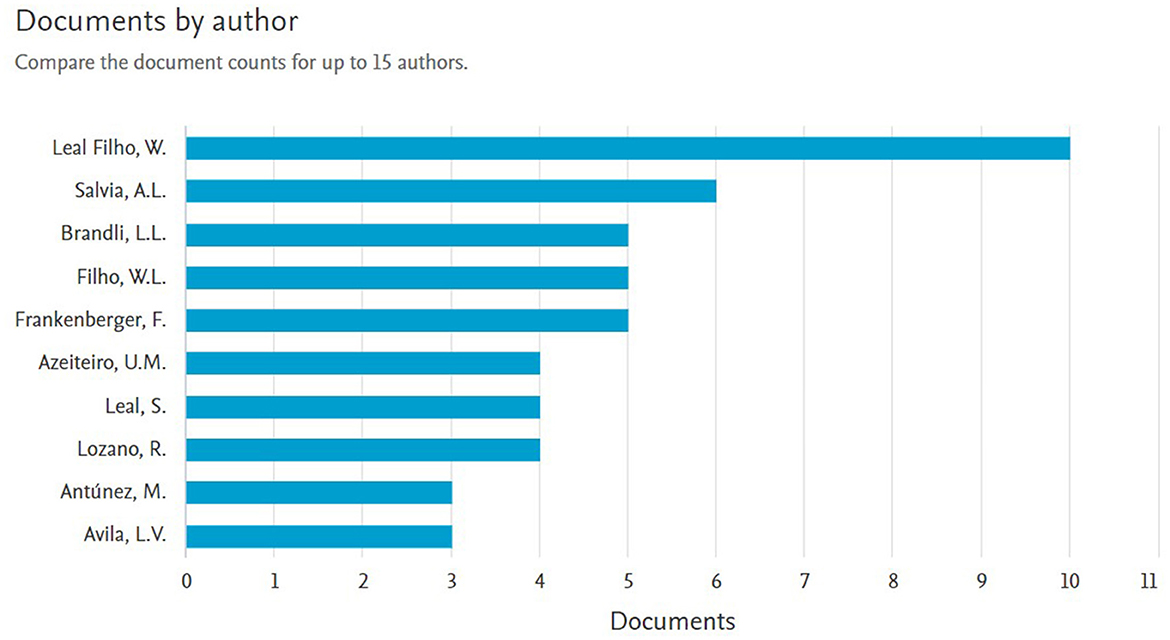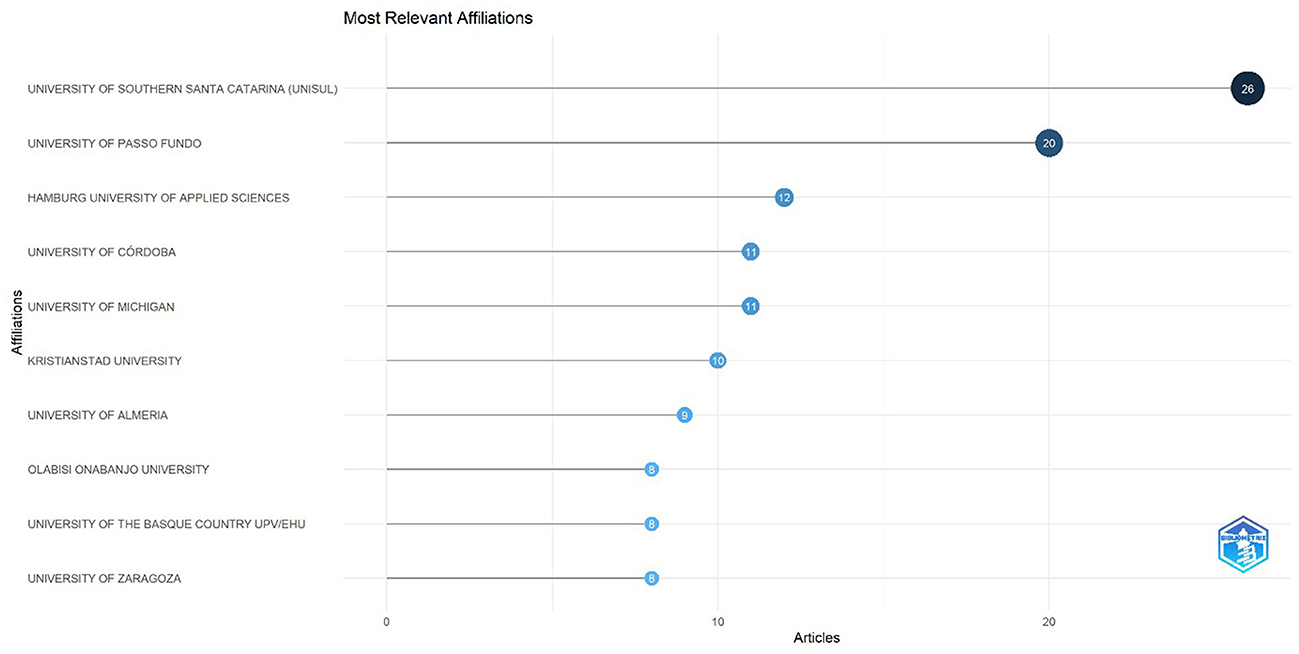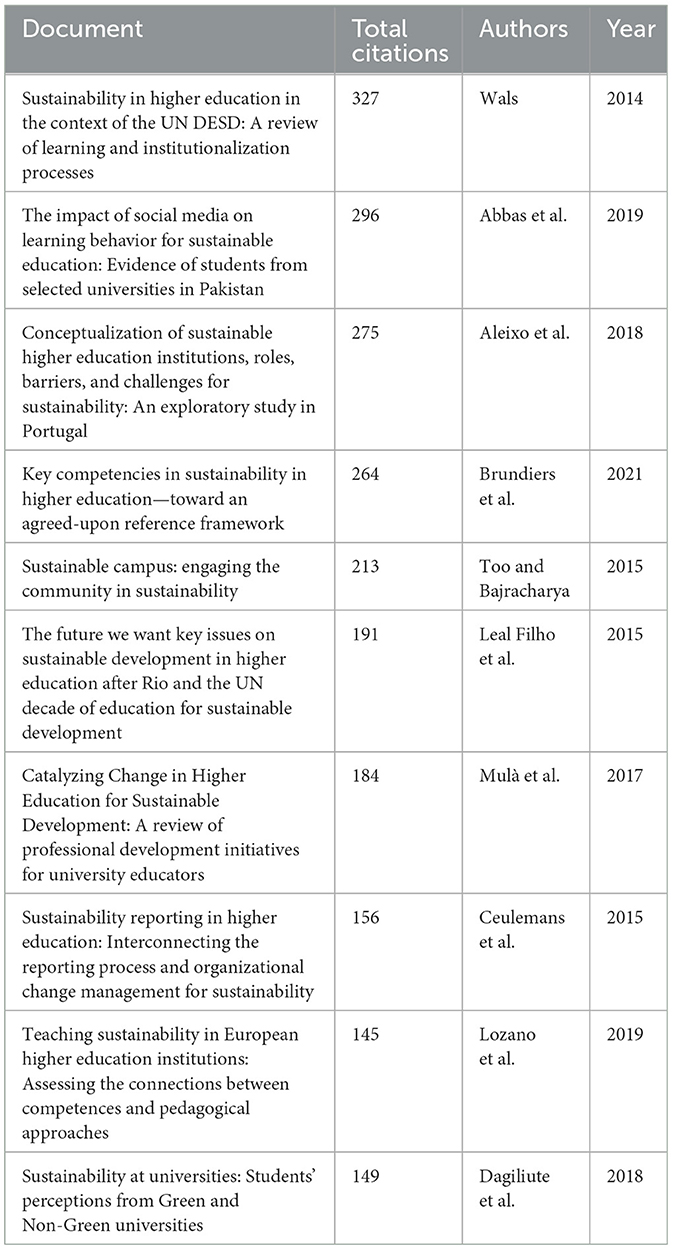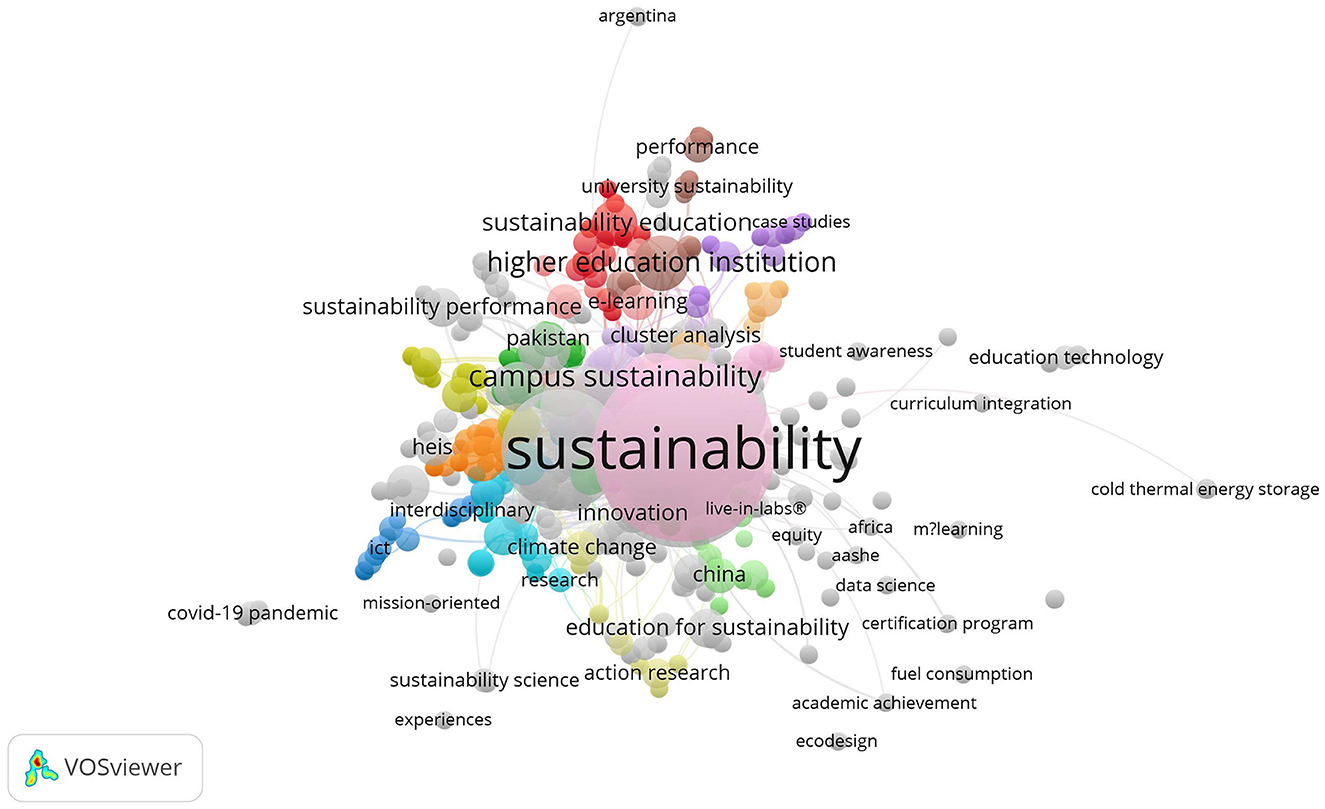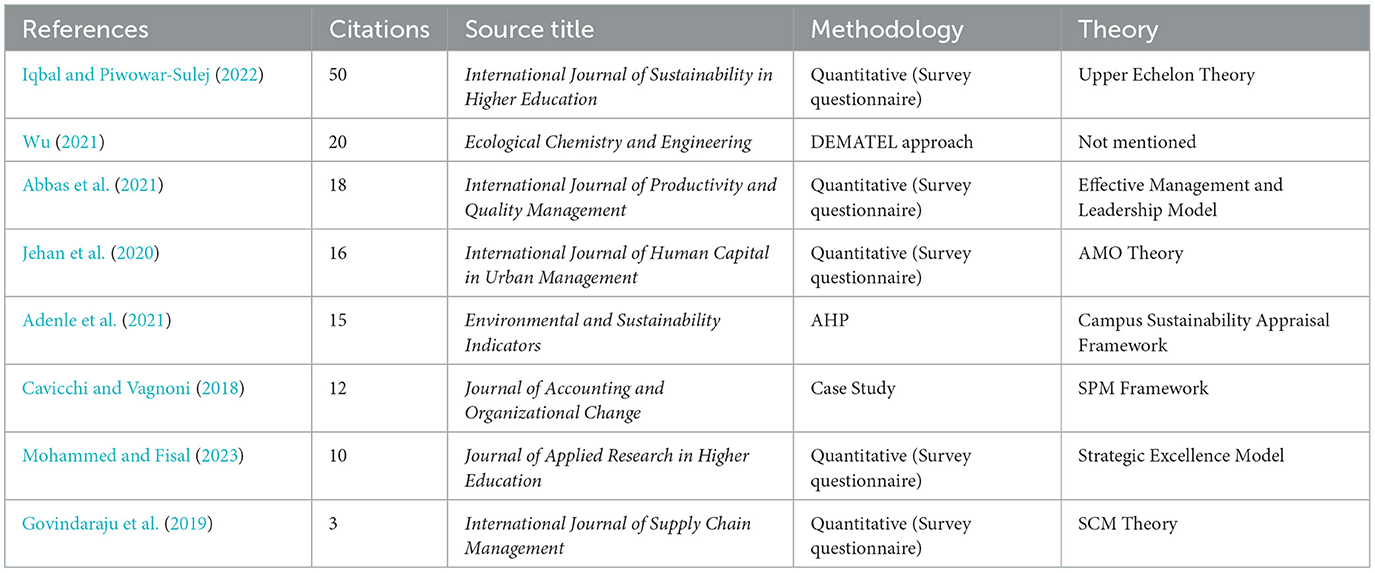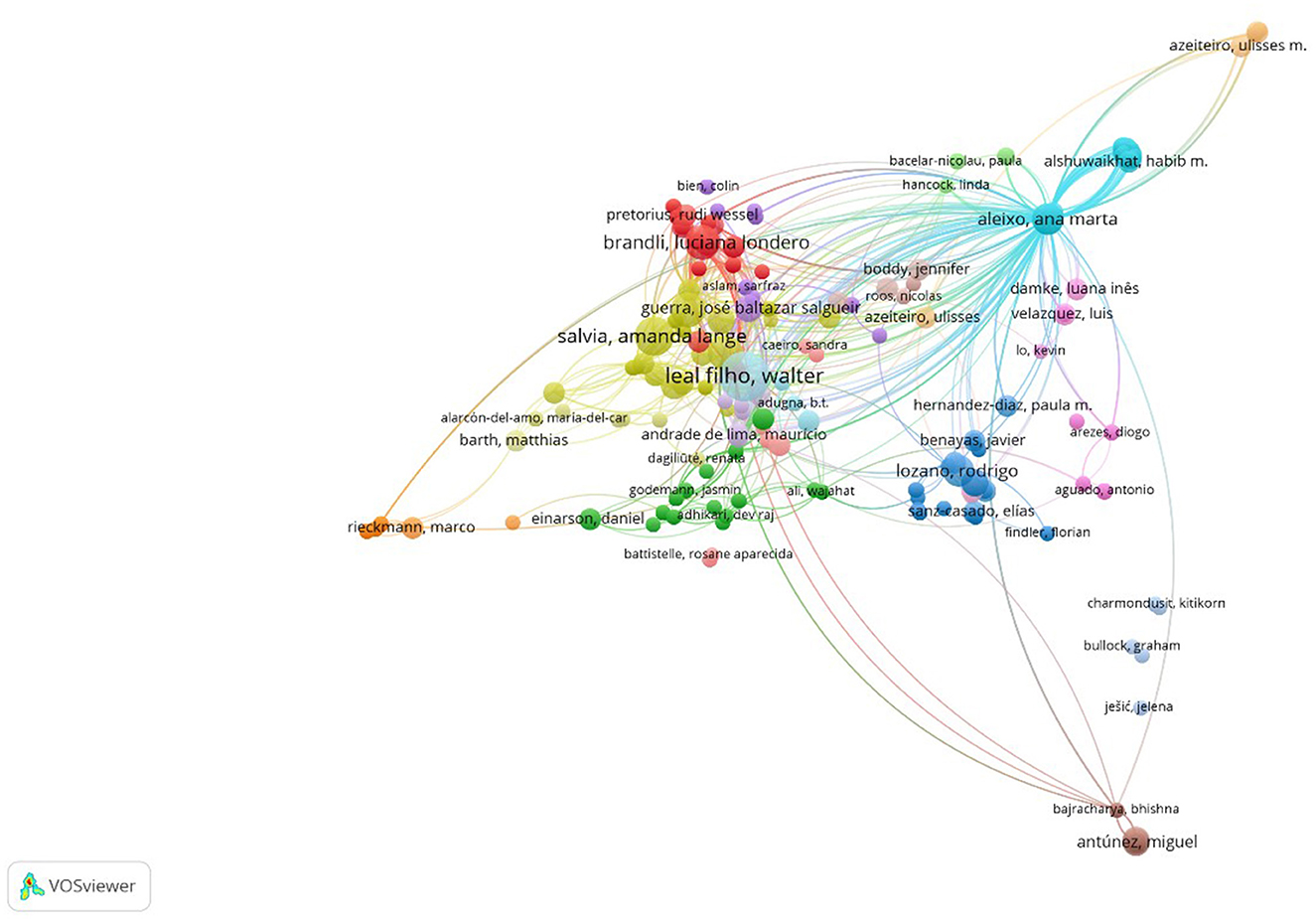- 1UKM- Graduate School of Business, Universiti Kebangsaan Malaysia, Bangi, Selangor, Malaysia
- 2Innovative University College, Petaling Jaya, Selangor, Malaysia
- 3Innovative School of Management, Shah Alam, Selangor, Malaysia
- 4Institute of Management Sciences, Bahauddin Zakariya University, Multan, Punjab, Pakistan
The sustainable performance of higher education institutes (HEIs) is key to efficiently manage educational institutes in the long run, to get financial aid from the government, and to keep the interest of stakeholders in the institutions. Researchers have focused on examining the impact of a sustainable curriculum, sustainable teaching methodologies, sustainable campuses, and tools for assessing sustainability in HEIs in past literature. The present bibliometric analysis, combined with network analysis, aims to explore the literature to identify research gaps in the field of sustainable performance or sustainability performance of HEIs. We have employed a Preferred Reporting Items for Systematic reviews and Meta-Analyses (PRISMA) flow diagram to analyze the results obtained from Scopus, Web of Science (WoS), and EBSCOhost databases. A bibliometric analysis using Biblioshiny web application and VOSviewer software was performed on the 263 articles included in the study after screening. The results revealed that the annual growth rate of publications is increasing, indicating that the sustainability performance of HEIs is gaining momentum after the introduction of the Sustainable Development Goals (SDGs) in 2017. The production of articles in the field is highest from advanced European countries and the United States, but only a few articles are published from Asian countries. The authors with the highest number of publications and the most cited research article in the field are Leal Filho and Wals, respectively. Authors keywords in HEIs (or institutions) not only have a strong link with sustainability, sustainable education, green campus, and sustainability assessment but also have a small network with sustainable performance, green knowledge sharing, green knowledge management, green human resource management practices, green teams, change management, and organizational commitment. These findings can be used by future researchers to identify unexplored research areas in different contexts.
1 Introduction
Sustainability has gained tremendous momentum in recent years and has received significant attention in a variety of fields, including education, business, agriculture, manufacturing, and transportation (Larivière and Smit, 2022). Higher education is also confronting a number of challenges related to sustainability. Therefore, higher education institutions (HEIs) have responded to these challenges by taking many initiatives for incorporating sustainability. HEIs have started addressing these challenges by planning and seeking solutions to modify and transform the way they perform business activities related to environmental performance, economic performance, and social performance.
Many HEIs have promoted sustainability and are actively engaged in preparing students to understand global challenges and provide solutions to these challenges based on the principles of sustainability. This can be accomplished by reducing the institution's environmental footprint, actively engaging with the communities, and imparting good governance (Lewis et al., 2021). In recent years, a growing body of knowledge has been developed toward higher education in order to implement a sustainability curriculum, campus practices, and outreach activities (Weiss and Barth, 2019; Menon and Suresh, 2020). Incorporating sustainability principles in HEIs is critical for improving the university's image, reputation, and study quality. The universities with the highest rankings are those that have a long-term vision for their students' development and have established a culture of sustainability (Salvioni et al., 2017; Singh et al., 2023).
The focus of research has been on sustainability in HEIs (Shriberg, 2002; Vargas-Merino et al., 2024), education for sustainability in HEIs (Figueiró et al., 2022), sustainability reporting in universities (Rosa et al., 2024), and Sustainable Development Goals (SDGs) in HEIs (Leal Filho et al., 2023). To the best of our knowledge, very few research studies have been devoted to the sustainable performance of the HEIs as business entities. The literature reviews on sustainability in HEIs mainly include internationalization efforts in HEIs through sustainability (Leal Filho et al., 2023), tools for assessing sustainability in HEIs (Singh et al., 2023), digital transformations in HEIs (Benavides et al., 2020), SDGs in HEIs (Serafini et al., 2022), evaluating service quality and performance of HEIs (Camilleri, 2021), organizational change management in HEIs (Rieg et al., 2021), carbon footprint in HEIs (Valls-Val and Bovea, 2021), knowledge management in HEIs (Quarchioni et al., 2020), and graduate employability and competence development in HEIs (Abelha et al., 2020). To the best of our knowledge, no literature review has been conducted yet to explore the sustainability performance of HEIs. Therefore, the following research questions have been developed:
• RQ1: What is the current trend in research for sustainable performance of HEIs?
• RQ2: Which theories and research methods are used to explain the sustainability performance of HEIs?
• RQ3: What is the influence or relationship of different fields on the sustainable performance of HEIs as reflected through keyword analysis?
2 Methodology
The study has adopted the Preferred Reporting Items for Systematic Reviews and Meta-Analyses (PRISMA) 2020 statement based on a 27-checklist item protocol and a four-phase flow diagram to confirm the transparency, robustness, and reliability of the search method (Page et al., 2021; Liberati et al., 2009) as provided in Figure 1. A bibliometric analysis using R package was carried out on 263 research articles selected by the PRISMA 2020 flow diagram. The choice of bibliometric study using PRISMA was made on the bases of the following reasons: (a) The quantitative analysis of the data obtained from bibliometric studies has higher accuracy, is easily interpretable, and provides a higher level of understanding of a specific field (Zhao et al., 2023; Iqbal et al., 2022) and (b) a bibliometric analysis conducted on the databases considering peer-reviewed journals is a reliable approach. In the present study, we have considered the articles relating to sustainability performance in HEIs from three world-wide renowned databases that are used by the research community: Scopus, Web of Science (WoS), and EBSCOhost. The Scopus and WoS databases are accepted as the world's leading and competing citation databases (Hassan et al., 2021; Zhu and Liu, 2020). The EBSCOhost database not only provides basic and advanced search options but also offers reliable and peer-reviewed content for specific searches (Wood, 2012). In addition, these databases provide a broad set of data that include the economic sciences and management sciences. Zemigala (2019) conducted a bibliometric analysis to investigate the number of articles and their total citations from top publishing educational centers or institutes by region in the field of sustainable development. The currently available bibliometric analysis in the literature lacks the identification of sustainable performance in HEIs. The present bibliometric study aims to address research gaps of bibliometric analysis in the sustainable performance in HEIs.
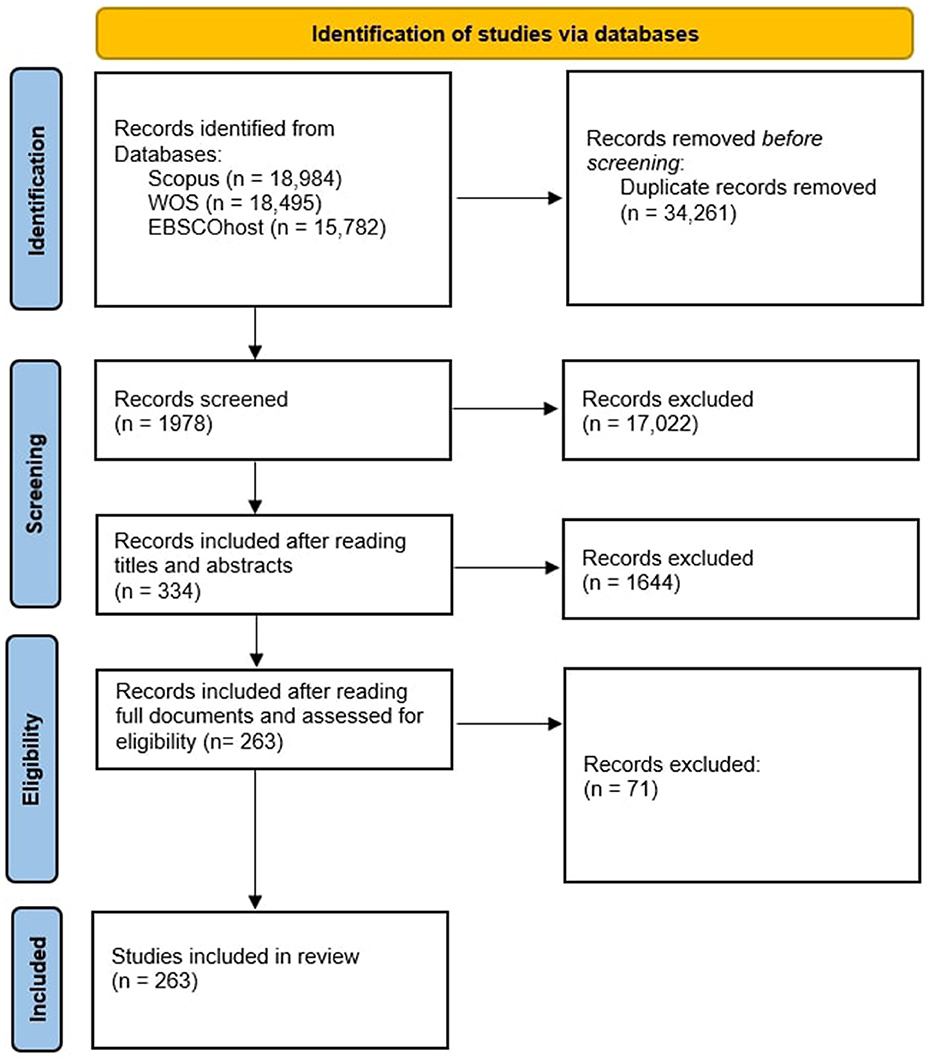
Figure 1. PRISMA flow diagram (Page et al., 2021).
2.1 Timeline
After the introduction of concerns about sustainability and the role of higher education in sustainability by the UN Conference on the Human Environment in 1972, the concept of “sustainable development” became internationally known in 1986 (Amaral et al., 2015). In HEIs, even student unions started pressurizing universities in Canada for higher sustainability in higher education (Elliott and Wright, 2013). The philosophical studies about sustainability challenges in HEIs started in the first decade of the 21st century (Hassan et al., 2021). In the present study, we limited the time period to the last 10 years (i.e., from 2014 to the March of 2024) because the number of relevant publications through our searches in the databases before 2014 were only two to three per year. Other reasons for gathering literature review of the last 10 years are the following: (a) consideration of the most recent articles and (b) the expectation of higher number of publications due to activities and interest in sustainability at HEIs after the introduction of the 17 Sustainable Development Goals (SDGs) by the United Nations Organization (Pradhan and Mariam, 2014).
2.2 Search strategy
A search of the WoS and Scopus databases was carried out with the different search phrases and Boolean operators (“OR” and “AND”) as follows: “Higher Education” OR “Higher Education Institutions” OR “HEIs” OR “University” (Trevisan et al., 2024), AND “Sustainability” OR “Sustainable Performance” OR “Sustainability Performance” (Alejandro-Cruz et al., 2019; Saulick et al., 2023). The number of search results on the WoS and Scopus databases were 80,323 and 18,984, respectively. The filters in search engines of all the databases were used to include the last 10-year research publications in the business field as search results show two to three articles per year before 2014 that focuses on the sustainability performance of HEIs. The other criterion for the inclusion is the articles published only in English. Data obtained from all three databases (i.e., WoS, Scopus, and EBSCOhost) were merged into a single file in RStudio to remove duplicate data and to retain only the unique results in a single Excel file with .csv extension. The resulting Excel file contained 1978 unique publications. In the next step, after reading the titles and abstracts of the publications, irrelevant research articles were removed from the list and a list of 334 articles was retained and used for further screening. In the last step, 71 research articles after a thorough reading of 334 articles were excluded as being irrelevant to the research questions of the study. Finally, 263 research articles were included for the systematic literature review, bibliometric analysis, and network analysis. The bibliometric analysis and network analysis were performed using R software's Biblioshiny application for bibliometric analysis and VOSviewer software for network analysis.
3 Results
The study employed a bibliometric analysis to summarize the research studies on sustainability in HEIs available in the literature in the last 10 years. The main findings of the research in the field of sustainability in HEIs are summarized in Table 1 using 263 articles obtained after screening results from the WoS, Scopus, and EBSCOhost databases. According to the bibliometric analysis, a total of 263 articles, with an average of 23.84 citations per article, were published across 17 journals over the last 10 years. The total number of authors who contributed to these articles is 949, and most of them have written only a single article, indicating that such authors most probably have not adopted the field for continuous improvement of sustainability performance in HEIs. The total number of authors' keywords is 848 for all the publications. The current trends of publications, theories, and methodology and the relevance of different fields with sustainable performance of HEIs are presented in subsequent sections.
3.1 Current trends of publications
The current trends in the field are reflected through the annual growth rate of publications, the number of citations in each journal, Bradford's law to identify the most prominent journals, a network analysis for most relevant countries, authors, and documents, and the most relevant affiliations.
3.1.1 Annual growth rate
The number of publications per year, as shown in Figure 2, depicts a continuous trend of increase in publications, with an annual growth rate of 17.46% from 2014 to March 2024. However, an exceptionally high increase in publications was observed in 2021 in that decade, which may be associated with an increase in the interest of the research community and other stakeholders in sustainability in HEIs due to the COVID-19 pandemic (Crawford and Cifuentes-Faura, 2022). The second and third highest number of articles were published in 2023 and 2022, with 48 and 37 articles, respectively. It can be observed that 25 articles have been published by the first quarter of 2024, and the number of articles in the relevant field at the end of 2024 is expected to exceed the number of publications in 2021. The number of articles in 2019 and 2020 were 28 and 22, respectively. There is a decreasing trend of number of articles published from 2018 onwards as only 16 articles were published in 2018, 17 in 2017, and eight in 2015. The least number of articles published in the field of sustainability in HEIs was in 2016. A major reason for the increasing trend in the number of publications is this field of study has been sustainability in HEIs gaining the attention of scholars because of the growing interest of governments and stakeholders of HEIs for making their institutes more sustainable by adopting sustainable practices, sustainable curriculum, sustainable teaching methods, and sustainable buildings. This field of study is garnering attention in both developed and developing countries at the same time (Nguyen et al., 2022).
3.1.2 Most relevant journals
The total number of citations for the 263 selected articles in the field of sustainability in HEIs obtained from the 17 journals was 6,271. The distribution of the number of articles and their total citations for different journals is provided in Table 2. These results show that three journals published articles that were cited more than 1,000 times. Among them, the Journal of Sustainability ranks first, with the highest number of publications and the total citations being 104 and 2,378, respectively. The International Journal of Sustainability in Higher Education ranks second, with the number of publications and number of citations being 87 and 2010, respectively. The third rank is obtained by the Journal of Cleaner Production with 35 articles and 1,292 citations. The Journal of Environment Development and Sustainability is ranked fourth with 10 articles and 242 citations, whereas the Journal Environmental Education Research is ranked fifth with only four articles and 133 citations. The rest of the 12 journals have the total number of articles ranging from one to three and citations ranging from 0 to 100 (for details see Table 2).
3.1.3 Bradford law
The majority of the publications were focused on a very small number of sources, whereas the remaining journals had published fewer than three articles related to sustainable performance in HEIs. Bradford's law categorizes the core sources. It demonstrates that “if the journals containing articles on a given subject are arranged in descending order of the number of articles they carried on the subject, then successive zones of periodicals containing the same number of articles on the subject form the simple geometric series 1:n:n2:P and Bradford called the first zone, the nucleus of periodicals particularly devoted to the given subject” (Alabi, 1979). The “core zone” is the very first zone, which consists of four journals with 236 publications, including Journal of Sustainability, Journal of Cleaner Production, Sustainability Science Journal, International Journal for Sustainability in Higher Education, and Environment, Development and Sustainability Journal. The second zone comprised of only 24 articles, as shown in Figure 3, including articles from Sustainability Science Journal, Environmental Education Research Journal, Higher Education Journal, International Journal of Educational Management, and Studies in Higher Education. The rest of the sources have very few citations. The Journal of Cleaner Production has the highest total link strength among all the sources.
3.1.4 Most relevant countries
A network analysis was performed for determining the total number of articles from different countries in the field of sustainability in HEIs (see Figure 4). The highest number of articles (i.e., 43) in the field were published from Spain with total citations and a total link strength of 1,470 and 42, respectively. The second highest number of articles (i.e., 37) in the field were published from Brazil, with total citations and a total link strength of 691 and 78, respectively. UK is ranked third with respect to the number of articles (i.e., 33) and citations (i.e., 1,302), and Germany ranks fourth with a total link strength of 68 for 30 publications with total citations of 735. There have been 23 documents published from Portugal in the field of sustainability performance of HEIs with total citations of 733 and total link strength of 54. The United States and Malaysia have published 16 and 13 articles in the field, with 496 and 418 citations and total link strength of 44 and 39, respectively. Thailand and Japan have the least number of publications, i.e., three from each country with 120 and 28 citations and a total link strength of 21 and 17, respectively. Canada, Saudi Arabia, Italy, Sweden, and the Netherlands are among the most relevant countries, with the number of publications being 10, 13, 14, 12, and 9, respectively.
3.1.5 Most relevant authors
We have also determined the number of documents in the field of sustainability in HEIs by authors (see Figure 5). According to the results, Leal Filho from Hamburg University is the author with the highest number of articles (i.e., 15) in the relevant field. Salvia from Hamburg University of Applied Sciences has published the second highest number of articles (i.e., six) related to sustainability in HEIs. The authors Brandli and Frankenberger have published five articles each in the field. Four publications have been authored by Azelterio and Lealand Lozano, whereas Antunez and Avila have published three publications each. The network analysis of citations per author using VOSviewer is presented in Figure 6. The analysis is run by using “author” as a unit of analysis and the minimum number of documents of an author was set at one. From the results, 955 authors met the threshold. The most cited authors are Alexio and Leal as both of them have 386 citations for only four publications with a total link strength of 222. Leal Filho has the highest total link strength of 225 for 10 publications with 225 citations. Azeiteiro has 279 citations for only two publications with a total link strength of 145. Salvia and Brandli, respectively, have 220 and 207 citations for six and five documents with a total link strength of 148 and 82. Guera, Paco, and Frankenberger are among the most significant authors in the field with a total link strength of 106, 105, and 90.
3.1.6 Most relevant documents
The citation analysis with relevant titles, citations, contributing authors, and year of publications for the first 10 articles is presented in Table 3. The most cited article in the field was published by Wals (2014), with 327 citations interlinked with other authors, and Abbas et al. (2019) and Aleixo et al. (2018) are the second and third most cited authors, with 296 and 275, respectively. Among the most recent research, Brundiers et al. (2021) obtained a highest citation of 264 from other authors and has a dominant cluster in the recent 5 years. Too and Bajracharya (2015) have 213 citations preceding Leal Filho et al. (2015) who have 191 citations for their publication. Mulà et al. (2017) and Ceulemans et al. (2015) have 184 and 156 citations, respectively, for the publications. Among the top 10 authors, Dagiliute et al. (2018) and Lozano et al. (2019) have the least number of citations, i.e., 149 and 145, respectively.
3.1.7 Most relevant affiliations
The list of most relevant affiliations include 477 universities and institutes from which a remarkable number of research articles were published (Figure 7). The University of Southern Santa Catarina is the most prominent university with 26 publications. Hamburg University of Applied Sciences, University of Cordoba, and University of Michigan have published 12, 11, and 11 articles, respectively. Kristandad University and University of Almeria have contributed 10 and 9 articles, respectively. Additionally, nine publications each have come from Olabisi Onbanjo University, University of the Basque Country UPV/ EHU, and University of Zaragoza. However, although the prominent institutions are presented in Figure 7, there are several universities from UAE, India, Pakistan, Malaysia, Thailand, and China that have published research articles in the field of sustainability performance of HEIs.
3.2 Theories and methodology in most relevant document
A meticulous analysis revealed that very few have focused on measuring sustainability performance or sustainable performance in HEIs specifically. The appreciable increase in the number of publications in the field of sustainability in HEIs in the timeline points out that the importance of sustainability development is garnering attention globally. Table 4 represents the authors, year of publications, source title, methodology, and theories employed for the most cited publications measuring the sustainable performance of HEIs. Iqbal and Piwowar-Sulej (2022) have employed the upper echelons theory and used the Sustainability Tracking, Assessment and Rating System (STARS) scale to measure the sustainable performance of HEIs through a survey questionnaire method. The Decision Making Trial and Evaluation Laboratory (DEMATEL) approach is used to evaluate the sustainable performance of a green university (Wu, 2021). Effective management and leadership approach is used in the research to measure the effect of servant leadership on the sustainable performance of HEIs as an organization through a survey questionnaire (Abbas et al., 2021). The researchers have used the ability, motivation, and opportunities (AMO) theory to predict the relationship between green HR practices and environmental (sustainable) performance of HEIs and collected data using a five-point Likert scale through a questionnaire (Muhammad Ali and Nisar, 2023). Adenle et al. (2021) have used the analytic hierarchy process as a performance of HEIs. The sustainability performance measurement (SPM) model is used in a case study by an Italian university to analyze the implementation of sustainable performance in the university (Cavicchi and Vagnoni, 2018). The sustainability of HEIs is measured through green human resources management (GHRM) practices and mediation of strategic excellence in Iraqi institutes by administering a survey-based questionnaire and strategic excellence model (Mohammed and Fisal, 2023). The supply chain management theory was employed to explain the relationship between top management support and private university sustainable performance in Malaysia by using a quantitative survey-based questionnaire (Govindaraju et al., 2019).
3.3 Keyword analysis
Keywords are used to describe the research field and relevance of the research fields with each other so that other researchers can easily discover the relevant document through an online search (Iqbal et al., 2022). However, bibliometric analysis uses both “authors keywords” and “keywords plus” as units of analysis, yet “authors keywords” is considered a more comprehensive research methodology and Campus Sustainability Appraisal Framework to measure sustainability in representing the content of the document and therefore used more frequently as a unit of analysis instead of “keywords plus.” Keyword co-occurrence is a highly effective method for visually representing the organization of scientific information. It allows for the identification of prominent areas of research and helps to detect patterns within a certain topic.
3.4 Network analysis
A co-occurrence analysis with “Authors keywords” as a unit of analysis was performed with a minimum co-occurrence of one, as shown in Figure 8. The data show “sustainability” as the authors keyword with the highest frequency of occurrence, that is, 103 times. The second most frequent authors keyword was “higher education,” with an occurrence score of 82 and “sustainable development” ranks third, with an occurrence score of 52. The authors keyword “higher education institutions” has an occurrence score of 43, taking the fourth position. The fifth and sixth positions are assigned to “education for sustainable development” and “sustainable development goals,” with occurrence scores of 29 and 26, respectively. University, SDGs, campus sustainability, sustainability reporting, and sustainable campus are among the prominent authors' keywords in the network analysis.
There are a total of 53 clusters with a minimum cluster size of five. The details of small clusters are provided subsequently to identify the gaps in the literature. Furthermore, keywords analysis shows that organizational change management, university leadership, and sustainability keywords with small cluster sizes are linked together in the first cluster, which consists of 53 items. Cluster 2 has 37 items and fewer links of higher education institutions have been found with servant leadership, economic growth, e-learning, and organizational commitment. Sustainable organizational performance is interlinked with organizational commitment, green teams, and servant leadership. There are a small number of linkages among green organizational performance, green knowledge sharing, green innovation, HEs, job satisfaction, and sustainable leadership in the third cluster with 34 items. In the fourth cluster (with 32 items), the links exist among environmental sustainability, sustainable universities, HEIs, change management, green human resource management, green knowledge management, and decision support framework. The keywords interconnected in the fifth cluster include links among green university with performance measurement, resource management, stakeholders, and sustainability office. Similarly, the sixth cluster has links of higher education with green organizational performance, green knowledge sharing, green innovation, job satisfaction and sustainable performance. Sustainable university is interconnected with developing countries, assessment systems, higher education, green campus, and sustainable development. Combining all the results shows that higher education institutions have a strong link with sustainable performance, sustainability performance, sustainability reporting, sustainable university, governance, agenda 2030, and public university.
4 Discussion
Sustainable performance and HEIs have been studied independently for the past few decades. Sustainability in HEIs or at campuses has gained extensive attention in the recent literature due to its critical role in ensuring the attainment of the goals of a sustainable society. Many researchers have focused on case study as a research methodology to gain insights into the lifecycle assessment of HEIs (Jürgens et al., 2023), the context and concept of HE for sustainable development (Adhikari and Shrestha, 2024), incorporating sustainability in the curriculum of mechanical engineering (Habek et al., 2024), and universities adopting sustainability transfers to transform regions (Demele et al., 2021). Other researchers have examined the role of SDGs and sustainability teaching at universities (Leal Filho et al., 2019), the influence of mobile learning on sustainability in HE (Al-Rahmi et al., 2022), administration perspective adopting sustainable practices in Greek universities (Platitsa et al., 2024), and sustainable practices at HEIs in Asia (Leal Filho et al., 2022).
A research study focused on the integration of sustainability into the curriculum of legal education in Latvia (Jekabsone and Ratniece, 2024). Cotton et al. (2023) have investigated the impact of climate change curriculum on campus and compared on-campus and on-website sustainability images. Another study found a positive effect of green content assessment of curriculum on eco-labeling in HE (Okanović et al., 2021). However, there are very few studies that have been dedicated to investigating the sustainable performance of HEIs as a business entity. Specifically, Gutiérrez-Mijares et al. (2023) have reviewed the methods for assessing sustainability performance of HEIs. Future researchers should explore different dimensions of sustainable performance that can be used to measure the impacts of different variables on HEIs so that sustainable performance on HEIs as a business entity should not be neglected. Some researchers have measured the sustainable performance of property development companies in Malaysia (Bakri and Abbas, 2020), dairy industry in Pakistan (Shoaib et al., 2022), hotel industry in Australia (Patiar and Wang, 2016), and petrochemical industries in Saudi Arabia (Althnayan et al., 2022). Although the sustainable performance of HEIs in the education industry has been measured through green campus, campus sustainability, and or sustainable building models, very few articles have focused on exploring the sustainability performance of HEIs as a business entity. This phenomenon has gained pace during post-COVID-19 period when many private HEIs have to shut down their businesses because of poor sustainable performance. Research has shown that HEIs that have focused on sustainable performance of HEIs were able to operate and pursue their business activities even in the period of economic crises. Therefore, it has been suggested that HEIs should opt to achieve sustainable performance in this highly competitive and rapidly changing global market.
Bibliometric analysis and network analysis of country production over time shows that most of the researches originate from European and developed countries like the United Kingdom, Germany, Portugal, and the United States as well as from the developing country of Brazil. There are very few studies conducted in Asian countries like Malaysia, Thailand, Japan, and Saudi Arabia. Moreover, studies that have been conducted in developing countries are not remarkable in terms of citations or their impact on other researchers. Therefore, future researchers should explore the factors contributing to the sustainable performance of HEIs in Asian countries with a more robust theoretical framework. The slow growth rate of research in the sustainable performance of HEIs is attributed to the period of adoption of sustainability practices in HEIs before the introduction of SDGs 2030 Agenda for Sustainable Development by the United Nations. After the introduction of SDGs in 2017 by the United Nations, the research focus on sustainability in HEIs relatively increased, yet the increase in the number of publications in the field is not very impressive. The growth rate of publications has skyrocketed during COVID-19 (2021) and has been continued at a remarkable pace in 2022, 2023, and until March 2024. The geographic concentration of the research publications is in the developing country of Brazil and in some developed countries like Germany, Spain, and The Netherlands. However, there are only few studies focusing on the assessment of sustainable performance in HEIs in developing countries; however, no prior research can be located in the field that measures the sustainable performance of the HEIs as a business entity. Therefore, future studies should fill the gap in the literature by exploring the factors contributing to the sustainable performance of HEIs as a business entity. The bibliometric analysis combined with network analysis for the sustainable performance research in HEIs has identified the key issues and areas of research neglected previously. There are five units of analysis that are most commonly used in bibliometric analysis: annual growth rate, authors, sources, territory or geographical location, and theme or keywords. This research helps identify the key research areas for HEIs to achieve and or maintain their sustainable performance and also helps to identify gaps in the literature. Researchers in the future can use the findings of this study to initiate new research projects on the topics that have rarely or never been researched in the past. The current growth of research publications indicates the interest of all stakeholders of HEIs in this field who can provide funding for such projects, influencing policymaking, interventions, and developments for sustainable performance of HEIs. The higher concentration of publications in the developed countries in the West shows an urgent need to initiate such studies in Asian and African countries as well, where a small number of studies have been focused on sustainability in the past literature. The network analysis shows that sustainable performance, knowledge sharing, green teams, change management, servant leadership, green human resource management, organizational commitment, and developing countries have rarely co-occurred on a level similar to higher education institutions, higher education institutes, green campus, and HEIs. These findings can be used by future researchers to adopt a framework that has been studied not so frequently in different contexts.
5 Conclusion
The bibliometric analysis integrated with network analysis in a study presenting the scientific mapping of sustainable performance of HEIs extends the understanding of the field by analyzing current trends in the literature. The contribution of this study is exploring the sustainable performance of HEIs from an entirely new perspective. The results show that the growth of publications shows that there was a surge in the number of articles published after 2016, and this growth rate reached its peak during the COVID-19 period. The list of most relevant countries includes 69 territories among which Spain and UK have published the most cited articles. The top 20 countries that have published articles are from Europe, Asia, and South Africa. There is a gradual increase in the number of institutions publishing articles in the field with an increase in the annual growth of publications, which confirms the development of the research field of sustainable performance of HEIs. Specifically, the most relevant authors have published in the year 2021 and, in subsequent years, the number of publications has increased. Thus, this study has helped to identify the key areas, assessment tools, theoretical frameworks, and research methodology adopted in the past studies to visualize the origin of the field and when and how it has evolved.
Data availability statement
The original contributions presented in the study are included in the article/supplementary material, further inquiries can be directed to the corresponding author.
Author contributions
SU: Conceptualization, Writing – review & editing, Supervision. JA: Conceptualization, Formal analysis, Methodology, Software, Writing – original draft, Writing – review & editing. MB: Conceptualization, Resources, Writing – review & editing. KM: Conceptualization, Supervision, Writing – review & editing. WW: Supervision, Writing – review & editing.
Funding
The author(s) declare financial support was received for the research, authorship, and/or publication of this article. This research was funded by Geran Penyelidikan UKM-GSB 2024, research code: GSB-2024-005.
Acknowledgments
We thank all our teachers and supervisory committee at UKM-GSB, Bangi, Malaysia, for guidance and support for the completion of this study.
Conflict of interest
The authors declare that the research was conducted in the absence of any commercial or financial relationships that could be construed as a potential conflict of interest.
Publisher's note
All claims expressed in this article are solely those of the authors and do not necessarily represent those of their affiliated organizations, or those of the publisher, the editors and the reviewers. Any product that may be evaluated in this article, or claim that may be made by its manufacturer, is not guaranteed or endorsed by the publisher.
References
Abbas, A., Saud, M., Ekowati, D., Usman, I., and Suhariadi, F. (2021). Servant leadership: a strategic choice for organizational performance. An empirical discussion from Pakistan. Int. J. Product. Qual. Manag. 34, 468–485. doi: 10.1504/IJPQM.2021.120599
Abbas, J., Aman, J., Nurunnabi, M., and Bano, S. (2019). The impact of social media on learning behavior for sustainable education: evidence of students from selected universities in Pakistan. Sustainability 11:1683. doi: 10.3390/su11061683
Abelha, M., Fernandes, S., Mesquita, D., Seabra, F., and Ferreira-Oliveira, A. T. (2020). Graduate employability and competence development in higher education—a systematic literature review using PRISMA. J. Sustain. 12:5900. doi: 10.3390/su12155900
Adenle, Y. A., Chan, E. H., Sun, Y., and Chau, C. K. (2021). Assessing the relative importance of sustainability indicators for smart campuses: a case of higher education institutions in Nigeria. Environ. Sustain. Ind. 9:100092. doi: 10.1016/j.indic.2020.100092
Adhikari, D. R., and Shrestha, P. (2024). The context and concept of higher education for sustainable development: the case of Nepal. Int. J. Sustain. High. Educ. 25, 238–264. doi: 10.1108/IJSHE-12-2021-0521
Alabi, G. (1979). Statistical analysis of journal usage. Int. Libr. Rev. 11, 141–150. doi: 10.1016/0020-7837(79)90043-8
Aleixo, A. M., Leal, S., and Azeiteiro, U. M. (2018). Conceptualization of sustainable higher education institutions, roles, barriers, and challenges for sustainability: an exploratory study in Portugal. J. Clean. Prod. 172, 1664–1673. doi: 10.1016/j.jclepro.2016.11.010
Alejandro-Cruz, J. S., Rio-Belver, R. M., Almanza-Arjona, Y. C., and Rodriguez-Andara, A. (2019). Towards a science map on sustainability in higher education. Sustainability 11:3521. doi: 10.3390/su11133521
Al-Rahmi, A. M., Al-Rahmi, W. M., Alturki, U., Aldraiweesh, A., Almutairy, S., Al-Adwan, A. S., et al. (2022). Acceptance of mobile technologies and M-learning by university students: an empirical investigation in higher education. Educ. Inf. Technol. 27, 7805–7826. doi: 10.1007/s10639-022-10934-8
Althnayan, S., Alarifi, A., Bajaba, S., and Alsabban, A. (2022). Linking environmental transformational leadership, environmental organizational citizenship behavior, and organizational sustainability performance: a moderated mediation model. Sustainability 14:8779. doi: 10.3390/su14148779
Amaral, L. P., Martins, N., and Gouveia, J. B. (2015). Quest for a sustainable university: a review. Int. J. Sustain. High. Educ. 16, 155–172. doi: 10.1108/IJSHE-02-2013-0017
Bakri, N., and Abbas, S. (2020). The role of transformational leadership in promoting sustainability among property development companies in Malaysia. Int. J. Organ. Leadersh. 9:123.
Benavides, L. M. C., Tamayo Arias, J. A., Arango Serna, M. D., Branch Bedoya, J. W., and Burgos, D. (2020). Digital transformation in higher education institutions: a systematic literature review. Sensors 20:3291. doi: 10.3390/s20113291
Brundiers, K., Barth, M., Cebrián, G., Cohen, M., Diaz, L., Doucette-Remington, S., et al. (2021). Key competencies in sustainability in higher education—toward an agreed-upon reference framework. Sustain. Sci. 16, 13–29. doi: 10.1007/s11625-020-00838-2
Camilleri, M. A. (2021). Evaluating service quality and performance of higher education institutions: a systematic review and a post-COVID-19 outlook. Int. J. Qual. Serv. Sci. 13, 268–281. doi: 10.1108/IJQSS-03-2020-0034
Cavicchi, C., and Vagnoni, E. (2018). Sustainability performance measurement inside academia: the case of a north Italian University. J. Account. Organ. Change 14, 138–166. doi: 10.1108/JAOC-04-2016-0022
Ceulemans, K., Lozano, R., and Alonso-Almeida, M. D. M. (2015). Sustainability reporting in higher education: interconnecting the reporting process and organisational change management for sustainability. Sustainability 7, 8881–8903. doi: 10.3390/su7078881
Cotton, D., Winter, J., Allison, J. A., and Mullee, R. (2023). Visual images of sustainability in higher education: the hidden curriculum of climate change on campus. Int. J. Sustain. High. Educ. 24, 1576–1593. doi: 10.1108/IJSHE-09-2022-0315
Crawford, J., and Cifuentes-Faura, J. (2022). Sustainability in higher education during the COVID-19 pandemic: a systematic review. Sustainability 14:1879. doi: 10.3390/su14031879
Dagiliute, R., Liobikiene, G., and Minelgaite, A. (2018). sustainability at universities: students' perceptions from green and non-green universities. J. Clean. Prod. 181, 473–482. doi: 10.1016/j.jclepro.2018.01.213
Demele, U., Nölting, B., Crewett, W., and Georgiev, G. (2021). Sustainability transfer as a concept for universities in regional transformation—a case study. Sustainability 13:4956. doi: 10.3390/su13094956
Elliott, H., and Wright, T. (2013). “Barriers to sustainable universities and ways forward: A Canadian students' perspective,” in Proceedings of the 3rd World Sustainability Forum, 1–19.
Figueiró, P. S., Neutzling, D. M., and Lessa, B. (2022). Education for sustainability in higher education institutions: a multi-perspective proposal with a focus on management education. J. Clean. Prod. 339:130539. doi: 10.1016/j.jclepro.2022.130539
Govindaraju, B., Jeyasingam, J., Habib, M., ULetchmana, U., and SaRatnam, S. (2019). A structural equation model for the study of sustainable performance by Private Universities in Malaysia. Int. J. Supply Chain Manag. 8, 32–42. doi: 10.59160/ijscm.v8i1.2230
Gutiérrez-Mijares, M. E., Josa, I., Casanovas-Rubio, M. D. M., and Aguado, A. (2023). Methods for assessing sustainability performance at higher education institutions: a review. Stud. High. Educ. 48, 1137–1158. doi: 10.1080/03075079.2023.2185774
Habek, P., Palacz, M., and Saeed, F. (2024). Embedding sustainability into mechanical engineering master programs—a case study of the top Technical Universities in Europe. Sustainability 16:941. doi: 10.3390/su16020941
Hassan, S., Ghias, W., Saeed, S., Shaukat, M. O., and Abro, S. (2021). Research domain of innovative work behaviour: a bibliometric analysis of fifteen years research (2005-2020). Elem. Educ. Online 20, 3900–3927. doi: 10.17051/ilkonline.2021.01.431
Iqbal, A., Ramachandran, S., Siow, M. L., Subramaniam, T., and Afandi, S. H. M. (2022). Meaningful community participation for effective development of sustainable tourism: bibliometric analysis towards a quintuple helix model. J. Outdoor Recreat. Tour. 39:100523. doi: 10.1016/j.jort.2022.100523
Iqbal, Q., and Piwowar-Sulej, K. (2022). Sustainable leadership in higher education institutions: social innovation as a mechanism. Int. J. Sustain. High. Educ. 23, 1–20. doi: 10.1108/IJSHE-04-2021-0162
Jehan, Y., Hussai, D., Batool, M., and Imran, M. (2020). Effect of green human resource management practices on environmental sustainability. Int. J. Hum. Capital Urban Manage 5, 153–164. doi: 10.22034/IJHCUM.2020.02.06
Jekabsone, I., and Ratniece, L. (2024). Integrating sustainability into curriculum of legal education in Latvia: an insight into the main issues. J. Teach. Educ. Sustain. 25, 60–75. doi: 10.2478/jtes-2023-0016
Jürgens, M., Hartmann, K., Endres, H. J., and Spierling, S. (2023). Life cycle assessment of higher education institutions–method and case study. J. Clean. Prod. 430:139649. doi: 10.1016/j.jclepro.2023.139649
Larivière, B., and Smit, E. G. (2022). People–planet–profits for a sustainable world: integrating the triple-P idea in the marketing strategy, implementation and evaluation of service firms. J. Serv. Manag. 33, 507–519. doi: 10.1108/JOSM-01-2022-0033
Leal Filho, W., Coronado-Marín, A., Salvia, A. L., Silva, F. F., Wolf, F., LeVasseur, T., et al. (2022). International trends and practices on sustainability reporting in higher education institutions. Sustainability 1:12238. doi: 10.3390/su141912238
Leal Filho, W., Manolas, E., and Pace, P. (2015). The future we want: key issues on sustainable development in higher education after Rio and the UN decade of education for sustainable development, Int. J. Sustain. High. Educ. 16, 112–129. doi: 10.1108/IJSHE-03-2014-0036
Leal Filho, W., Shiel, C., Paço, A., Mifsud, M., Ávila, L. V., Brandli, L. L., et al. (2019). Sustainable Development Goals and sustainability teaching at universities: falling behind or getting ahead of the pack? J. Clean. Prod. 232, 285–294. doi: 10.1016/j.jclepro.2019.05.309
Leal Filho, W., Simaens, A., Paço, A., Hernandez-Diaz, P. M., Vasconcelos, C. R., Fritzen, B., et al. (2023). Integrating the sustainable development goals into the strategy of higher education institutions. Int. J. Sustain. Dev. World Ecol. 30, 564–575. doi: 10.1080/13504509.2023.2167884
Lewis, J., Schneegans, S., and Straza, T. (2021). UNESCO Science Report: The race against time for smarter development, Vol. 2021. Paris: Unesco Publishing.
Liberati, A., Altman, D. G., Tetzlaff, J., Murlow, C., Gøtzche, P. C., Loannidas, J. P. A., et al. (2009). The PRISMA Statement for reporting systematic reviews and meta-analyses of studies that evaluate health care interventions: explanation and elaboration. PLoS Med. 6, 1–28. doi: 10.1371/journal.pmed.1000100
Lozano, R., Barreiro-Gen, M., Lozano, F. J., and Sammalisto, K. (2019). Teaching sustainability in European higher education institutions: assessing the connections between competences and pedagogical approaches. Sustainability 11:1602. doi: 10.3390/su11061602
Menon, S., and Suresh, M. (2020). Synergizing education, research, campus operations, and community engagements towards sustainability in higher education: a literature review. Int. J. Sustain. High. Educ. 21, 1015–1051. doi: 10.1108/IJSHE-03-2020-0089
Mohammed, A. A., and Fisal, M. Z. (2023). The nexus between green human resource management processes and the sustainability of educational institutions: the mediating effect of strategic excellence. J. Appl. Res. High. Educ. 15, 947–965. doi: 10.1108/JARHE-12-2021-0443
Muhammad Ali, Q., and Nisar, Q. A. (2023). Nexus between green human resource management and environmental performance: a green approach for higher education institutes. Kybernetes 52, 5706–5729. doi: 10.1108/K-01-2022-0023
Mulà, I., Tilbury, D., Ryan, A., Mader, M., Dlouhá, J., Mader, C., et al. (2017). “Catalysing change in higher education for sustainable development: a review of professional development initiatives for university educators. Int. J. Sustain. High. Educ. 18, 798–820. doi: 10.1108/IJSHE-03-2017-0043
Nguyen, H.-T., Ngoc, N., Trang, T., Duc, L., and Nguyen, P. M. (2022). Sustainable development of higher education institutions in developing countries: comparative analysis of Poland and Vietnam. Contemp. Econ. 16, 195–210. doi: 10.5709/ce.1897-9254.477
Okanović, A., Ješić, J., Ã?aković, V., Vukadinović, S., and Andrejević Panić, A. (2021). Increasing university competitiveness through assessment of green content in curriculum and eco-labeling in higher education. Sustainability 13:712. doi: 10.3390/su13020712
Page, M. J., McKenzie, J. E., Bossuyt, P. M., Boutron, I., Hoffmann, T. C., Mulrow, C. D., et al. (2021). The PRISMA 2020 statement: an updated guideline for reporting systematic reviews. BMJ 372:n71. doi: 10.1136/bmj.n71
Patiar, A., and Wang, Y. (2016). The effects of transformational leadership and organizational commitment on hotel departmental performance. Int. J. Contemp. Hosp. Manag. 28, 586–608. doi: 10.1108/IJCHM-01-2014-0050
Platitsa, V., Sardianou, E., Abeliotis, K., and Mitoula, R. (2024). Perspectives of the administration of Greek universities regarding the adoption of sustainability practices. Int. J. Sustain. High. Educ. 25, 1103–1118. doi: 10.1108/IJSHE-09-2023-0417
Pradhan, M., and Mariam, A. (2014). The global universities partnership on environment and sustainability (GUPES): Networking of higher educational institutions in facilitating implementation of the UN decade of education for sustainable development 2005–2014. J. Educ. Sustain. Dev. 8, 171–175. doi: 10.1177/0973408214548383
Quarchioni, S., Paternostro, S., and Trovarelli, F. (2020). Knowledge management in higher education: a literature review and further research avenues. Knowl. Manag. Res. Pract. 20, 304–319. doi: 10.1080/14778238.2020.1730717
Rieg, N. A., Gatersleben, B., and Christie, I. (2021). Organizational change management for sustainability in higher education institutions: a systematic quantitative literature review. Sustainability 13:7299. doi: 10.3390/su13137299
Rosa, M. R. D., Boscarioli, C., and Freitas Zara, K. R. D. (2024). A systematic review of the trends and patterns of sustainability reporting in universities. Int. J. Sustain. High. Educ. 25, 556–576. doi: 10.1108/IJSHE-12-2022-0399
Salvioni, D. M., Franzoni, S., and Cassano, R. (2017). Sustainability in the higher education system: an opportunity to improve quality and image. Sustainability 9:914. doi: 10.3390/su9060914
Saulick, P., Bokhoree, C., and Bekaroo, G. (2023). Business sustainability performance: a systematic literature review on assessment approaches, tools and techniques. J. Clean. Prod. 408:136837. doi: 10.1016/j.jclepro.2023.136837
Serafini, P. G., de Moura, J. M., de Almeida, M. R., and de Rezende, J. F. D. (2022). Sustainable development goals in higher education institutions: a systematic literature review. J. Clean. Prod. 370:133473. doi: 10.1016/j.jclepro.2022.133473
Shoaib, M., Nawal, A., Zámečník, R., Korsakiene, R., and Rehman, A. U. (2022). Go green! Measuring the factors that influence sustainable performance. J. Clean. Prod. 366:32959. doi: 10.1016/j.jclepro.2022.132959
Shriberg, M. (2002). Institutional assessment tools for sustainability in higher education: strengths, weaknesses, and implications for practice and theory. High. Educ. Policy 15, 153–167. doi: 10.1016/S0952-8733(02)00006-5
Singh, A. B., Meena, H. K., Khandelwal, C., and Dangayach, G. S. (2023). Sustainability assessment of higher education institutions: a systematic literature review. Eng. Proc. 37:23. doi: 10.3390/ECP2023-14728
Too, L., and Bajracharya, B. (2015). Sustainable campus: engaging the community in sustainability. Int. J. Sustain. High. Educ. 16, 57–71. doi: 10.1108/IJSHE-07-2013-0080
Trevisan, L. V., Leal Filho, W., and Pedrozo, E. Á. (2024). Transformative organisational learning for sustainability in higher education: a literature review and an international multi-case study. J. Clean. Prod. 447:141634. doi: 10.1016/j.jclepro.2024.141634
Valls-Val, K., and Bovea, M. D. (2021). Carbon footprint in higher education institutions: a literature review and prospects for future research. Clean Technol. Environ. Policy 23, 2523–2542. doi: 10.1007/s10098-021-02180-2
Vargas-Merino, J. A., Rios-Lama, C. A., and Panez-Bendezú, M. H. (2024). Critical implications of education for sustainable development in HEIs-a systematic review through the lens of the business science literature. Int. J. Manag. Educ. 22:100904. doi: 10.1016/j.ijme.2023.100904
Wals, A. E. (2014). Sustainability in higher education in the context of the UN DESD: a review of learning and institutionalization processes. J. Clean. Prod. 62, 8–15. doi: 10.1016/j.jclepro.2013.06.007
Weiss, M., and Barth, M. (2019). Global research landscape of sustainability curricula implementation in higher education. Int. J. Sustain. High. Educ. 20, 570–589. doi: 10.1108/IJSHE-10-2018-0190
Wu, C. H. (2021). An empirical study on discussion and evaluation of green university. Ecol. Chem. Eng. S, 28, 75–85. doi: 10.2478/eces-2021-0007
Zemigala, M. (2019). Tendencies in research on sustainable development in management sciences. J. Clean. Prod. 218, 796–809. doi: 10.1016/j.jclepro.2019.02.009
Zhao, X., Nan, D., Chen, C., Zhang, S., Che, S., Kim, J. H., et al. (2023). Bibliometric study on environmental, social, and governance research using CiteSpace. Front. Environ. Sci. 10:1087493. doi: 10.3389/fenvs.2022.1087493
Keywords: HEIs, higher education institutes, sustainability, sustainable performance, Bibliometric analysis
Citation: Umar SB, Ahmad J, Bukhori MABM, Mohd Ali KA and Wan HWMH (2024) A decade in review: bibliometric analysis of sustainable performance trends in higher education institutes. Front. Educ. 9:1433525. doi: 10.3389/feduc.2024.1433525
Received: 16 May 2024; Accepted: 13 August 2024;
Published: 09 September 2024.
Edited by:
Felister Nzuve, University of Nairobi, KenyaReviewed by:
Sarfraz Aslam, UNITAR International University, MalaysiaJorge Membrillo-Hernández, Monterrey Institute of Technology and Higher Education (ITESM), Mexico
Renate Wesselink, Wageningen University and Research, Netherlands
Copyright © 2024 Umar, Ahmad, Bukhori, Mohd Ali and Wan Hussain. This is an open-access article distributed under the terms of the Creative Commons Attribution License (CC BY). The use, distribution or reproduction in other forums is permitted, provided the original author(s) and the copyright owner(s) are credited and that the original publication in this journal is cited, in accordance with accepted academic practice. No use, distribution or reproduction is permitted which does not comply with these terms.
*Correspondence: Jawaria Ahmad, amF3YXJpYWFobWFkMkBnbWFpbC5jb20=; WlAwNDc4NkBzaXN3YS51a20uZWR1Lm15
 Shahawati Binti Umar
Shahawati Binti Umar Jawaria Ahmad
Jawaria Ahmad Muhammad Anas Bin Mohd Bukhori
Muhammad Anas Bin Mohd Bukhori Khairul Anuar Mohd Ali
Khairul Anuar Mohd Ali Wan Mohd Hirwani Wan Hussain1
Wan Mohd Hirwani Wan Hussain1